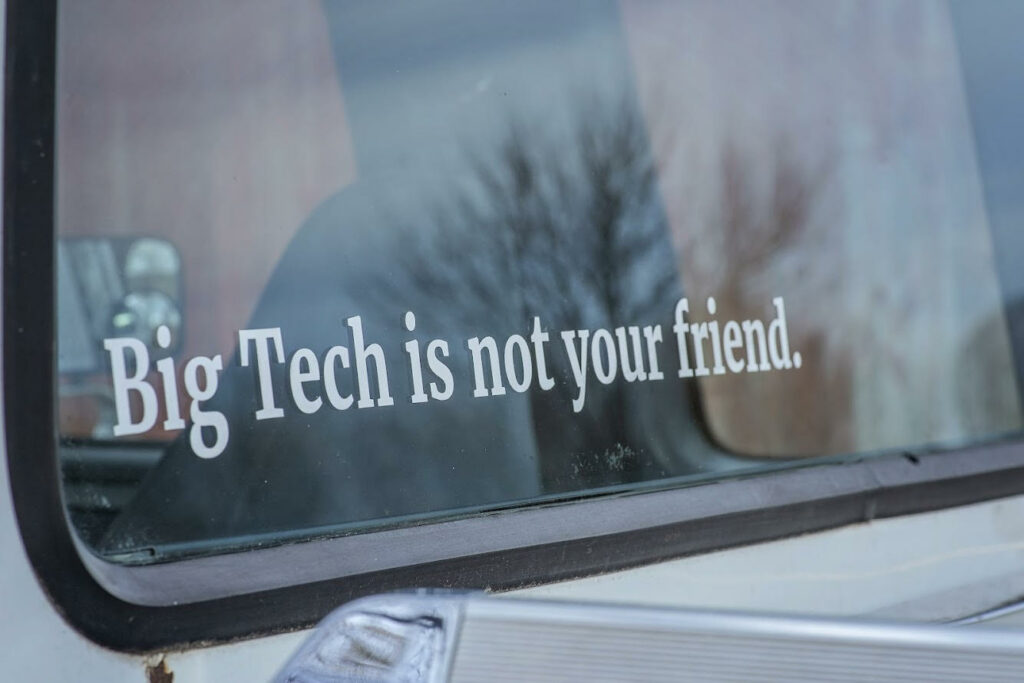Shelby County, IN. The main east-west thoroughfare in Shelby County, Indiana is IN-44. It’s a quintessential Hoosier state road. That is, it’s a two-lane means to an interstate end. Since 44 intersects both I-65 and I-74, it serves as a sort of rural bypass of Indianapolis. It’s a reality that is not lost on the state highway patrol. At least once a week, I’ll pass a member of law enforcement leveraging what little topography we have in our linear landscape. Those libertarian road warriors who think The Country allows them to channel Rockatansky or Rand will soon be reminded that all roads are toll roads after a certain speed. Certainly, the country is more laissez-faire, but that is a grace (generally) extended to us locals whose license plates have a “73” in the lower right.
The other day, I passed a State Trooper defiladed along the berm so well, it seemed more like a pending drone strike than a speed trap. While I was well within the acceptable levels of criminality, something about this felt particularly unsporting. Since I’m not a member of law enforcement I can only speak to the mindset of a speeder. However, when it comes to speed traps, I’ve found that there is an inverse relationship between reaction time allowed and subsequent righteous indignation felt. The next speeder’s fate would undeniably be sealed. So, when a pack of oncoming cars approached, I flashed my high beams.
Out of the four vehicles, only the driver of a pickup with a lift kit and primer for paint hit his brakes. In that fleeting moment that occurred as we passed, he lifted his fingers off the wheel in a sort of half wave. The gesture, and subsequent brake lights, triggered an almost startling sense of pride inside me. Not because I have an ax to grind with law enforcement, or because I’m some sovereign citizen who rejects the legitimacy of speed limits. To be honest, had it been a deputy sheriff from our county, I likely would have waved to them for standing sentry over our community. But this moment of camaraderie with the oncoming driver conjured a flood of memories from childhood, riding with my father, and the community we came from.
For those of you not raised in the Rust Belt, the Heartland, or whatever cultural toponym you prefer for being not rich, when an oncoming vehicle flashes their high beams—assuming your own aren’t on—it’s a warning that somewhere in the curves and contours ahead, an officer is waiting to add you to their monthly quota. It’s a sort of highway folkway. Like the biker wave, or how bored kids and truckers instinctively know what pumping a clenched fist out a minivan window means.
My father first taught it to me when I was maybe 10 years old, likely riding in an unbuckled state of nature on the front bench seat of his seafoam green Bonneville. Even then I remember it being catechized with a bizarre sense of obligation. That same tone fathers use when they tell sons to hold the door for a woman or address an elder with respect. It carried that societal ought. You remove your hat for the Anthem, you close your eyes for prayer, and you don’t let a neighbor surrender two days’ wages over a matter of malum prohibitum.
As a teenager, I questioned the practice until I paid my first $160.00 fine. Then I brooded equally over the officer who wrote the ticket as I did over the half-dozen priests and Levites whose apathy served as a sort of snitching-by-omission, selling out a fellow traveler on the road to Jericho.
As I drove on, I began to wonder who else besides us two pickup owners still knew about this code. My own truck is nearly 30 years old, and since driving diversions are limited to FM radio or the occasional flicker of the check engine light, I had time to ponder such things. So at the next stop, I posed the following to my wife by text:
“Question…if someone flashes their high beams at you, what would you take that to mean?”
My wife, through no fault of her own, had an upper-class, suburban childhood. She proceeded to explain, in detail, how it was part of a gang initiation ritual, sharing the plot from the 1998 Tara Reid movie Urban Legend.
I moved on to a couple friends with similar upbringings to my own.
“Cop ahead,” and “Slow down,” came the immediate replies.
I probed further. “OK. So, who taught you that?”
My one friend shared that it was his grandfather who drove a route for the Chicago gas company that initiated him. He fondly recalled how his grandpa was that guy who kept a CB radio in his own car. He instructed him that things like this were just what people who made their living on the road did for each other. The other friend, less willing to indulge such thought exercises, bluntly replied, “I dunno…was caught, not taught.”
I suspect such things will soon be neither taught nor caught. Forget about our aversion to generational wisdom, who among us feels any obligation outside of our own chosen relationships? At least it wasn’t me. They got what they deserved. Why’s it my responsibility to look out for them? Sure, we’ll parrot slogans like “we’re all in this together” during pandemics, but that’s just a passive-aggressive way of saying you better not get me sick. The one exception to this, of course, is if you were in an accident, those same people would certainly feel obligated to document the schadenfreude with their triple camera Galaxy Z Fold4 in stunning 8K. Don’t help; just film.
Maybe things aren’t (yet) that bad. Good Samaritans still stop to help stranded motorists, particularly in rural areas like ours. And my blunt friend tried to reassure me that my concern for dying highway mores was misplaced. He shared that it hasn’t been forgotten; it’s just gone digital with Waze and Google Maps. I countered that Alphabet cataloging every user that crowd-sources civil disobedience somehow felt more sinister than a speed trap. Besides, something about leveraging 39-years worth of global positioning system technology to do what the flick of a headlight can do seemed Rube Goldbergish.
Yet, what cultural atrophy doesn’t kill, our zeal for detached, unexamined technologies inevitably will. In the last few years, SAE International released the Taxonomy and Definitions for Terms Related to Driving Automation Systems for On-Road Motor Vehicles. It’s an automotive engineering standard that defines autonomous vehicle capabilities on a 0-5 scale. Level 0, like my truck, possesses no automation whatsoever, while Level 5 will ostensibly resemble something between Will Smith’s Audi in I, Robot and K.I.T.T.
The nomenclature of progress often exposes our true intentions. The Greek word autós forms the root for both automobile and autonomous car. While the former simply means self-propelling, the latter is self-governing. Technocrats have a fondness for extrajudicial governance. They get away with it because we accept the premise that technology is morally neutral. As if the algorithms we live by are somehow not written and guided by individuals with values and worldviews of their own.
For most of the late 2010s, Silicon Valley led us to believe that we would all soon be chauffeured around like Jessica Tandy as we finished slide deck presentations and streamed Billions on our daily commute. However, after several years of this reality being only months away (not to mention the tragic results of live testing on actual streets) those promises have largely been memory-holed.
Currently, there are only a handful of Level 2 vehicles available in the United States. These are cars that utilize adaptive cruise control plus lane-assist technology. Of course anyone who’s ever taken a road trip knows that this has already been around for years in the form of asking a friend to hold the wheel while you fumble under your seat for a Pearl Jam CD. Earlier this year, however, Mercedes-Benz announced that they had released the first certified Level 3 vehicle approved in Germany. A MotorTrend writer who took a “test drive” wrote, apparently without irony:
You can sit back and relax. As long as you’re on an autobahn, traveling at 37 mph or less in daylight on a dry road and the ambient temperature is 40 degrees Fahrenheit or higher, Drive Pilot will take care of everything…
Take care of everything, indeed.
Even if our autonomous future is running a bit behind schedule, our tech overlords certainly won’t let that delay their war on human agency by way of electric vehicles (EVs). I could make the argument that determining the greenness of a car solely on the presence of an exhaust system overlooks a host of issues in the production, disposal, and overall utility of a vehicle (not to mention the question of how that electricity is generated). For now, though, let’s just focus on the idea of cars becoming a sort of mobile node in a transportation network.
A Tesla is not so much a car with an electric engine, as it is a car with an operating system. As such, we can expect EVs will inevitably and inextricably be under the tyranny of the Internet-of-Things (IoT). In the name of safety, efficiency, and better insurance rates, I suspect you’ll see cars either governed to posted limits, or real-time fines and points that start to accrue once you go 1-mph over. And, lest you think I’m the reactionary Luddite that I am, you’d do well to note the concept of usage-based insurance has been around for years. Progressive filed a patent for “A method and system of determining a cost of automobile insurance based upon monitoring, recording and communicating data representative of operator and vehicle driving characteristics,” not in 2017, but in 1997.
A growing number of insurance upstarts like Root and Lemonade require drivers to be monitored by GPS for several weeks before issuing coverage. The Lyft and Uber Driver apps, both originally built on the Google Maps infrastructure, alert contractors when they go over the posted speed limits. It’s naïve to think these capabilities won’t move from the background to becoming a sort of digital driving instructor, or worse. God may be your copilot, but Bezos takes the wheel.
However, even if I am misreading the map to our speed-free future, it still leaves other open questions such as who actually owns the car if GM or Ford forbid access to the IP necessary to repair or modify it. Just ask any farmer about what happens if they want to save seed or work on their John Deere X9 1100 combine. Or any BMW owner across the pond whose car is being transformed into a rolling monthly recurring revenue model.
And thus will come the end of a century-long rivalry between police and speeders. If you think the likelihood of talking your way out of a ticket with a stoic Trooper is slim, just wait for the algorithms. The death of the internal combustion engine will erase more than just carbon emissions.
It should be said that breaking the speed limit is not right. Chapter 13 of Paul’s letter to the Romans leaves little room for theological nuance for Christians living in an Empire. Nevertheless, there’s something that feels even less right with a system that precludes you from making the virtuous choice to submit.
Since having kids, I have come to resent the loss of our pettier freedoms and less complex ways of life the most. I certainly do not want my children to do some of the things that I did in, and with, cars, but I also recognize that there was something instructive in it. Driving a car is, paradoxically, one of the few acts where autonomy and unchosen obligation are held in some degree of harmony. The complete agency one has in being the sole CPU of two tons of steel requires something of us—attention, accountability, connection, grace. We exercise those virtues to our passengers, our community, pedestrians, the road, and our fellow drivers.
It is perhaps why a Liberal order so singularly focused on an ever-expanding definition of autonomy finds itself now wanting to shift that autonomy from us to the machines. In the case of me and my fellow pickup driver, any world that permits the transmission of illicit wisdom or warnings from those who have already traveled the road cannot be allowed to stand. That world will be missed even if we don’t realize it’s gone.
I’d like to think the driver of the other truck spent as much time as I have contemplating the larger, cultural implications of this brief encounter. But, it’s OK if he didn’t. I’ll settle for brake lights and a wave.






6 comments
Mark Mitchell
Great post, Rob. I look forward to reading more from you.
Robb
Thanks for the kind words, Mark.
ken
I like the play on autonomy. You’ve read Mathew Crawford’s “Why We Drive”?
Robb
I had not, but I plan on picking that up. Thanks for the recommendation, Ken.
Aaron
Nice article, Robb. I grew up on the county line, between Shelby and Rush, a few miles south of Gwyneville. Your rendition of the protocols of driving brought back a few memories of high school activites legal and less-legal.
Aaron
Robb
Thanks, Aaron. It’s certainly a small world!
Comments are closed.